New publications
Plants
Agapetes
Last reviewed: 11.03.2025
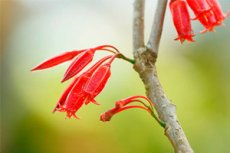
Agapetes (Latin: Agapetes) is a genus of evergreen shrubs or small trees that attract attention with their decorative flowers and vibrant foliage. The plant is primarily found in the mountainous regions of Southeast Asia and is known for its high ornamental value and relatively rare use in indoor horticulture. Due to its unusual bell-shaped flowers, Agapetes is highly valued by enthusiasts of exotic plants and collectors of rare species.
Etymology of the name
The name "Agapetes" originates from the Greek word agapetos, which means "beloved" or "dear." This reflects the aesthetic appeal and refined beauty of the flowers, which are often compared to small lanterns or bells. In botanical circles, the genus has retained its name due to a series of studies conducted in the mountainous regions of Asia, which were aimed at identifying new members of this genus.
Life form
Agapetes can grow as a low shrub, forming numerous branching stems with dense foliage. In its natural habitat, its shoots sometimes grow epiphytically (on the trunks and branches of trees), but when cultivated in pots, it usually takes the form of a compact shrub.
In some cases, under conditions of abundant moisture and suitable substrate, Agapetes may develop into a small tree, especially if it is not restricted by the size of the pot. However, even in such cases, the plant rarely exceeds 1–2 meters in height when grown indoors.
Family
Agapetes belongs to the heath family (Ericaceae), which includes a number of tropical and subtropical species, as well as plants from temperate regions (such as blueberries and cranberries). These plants are often characterized by bell-shaped flowers, which is an important common feature of the family.
Heaths are known for their ability to grow in acidic soils with a high humus content and low nutrient levels. Many of them form mycorrhizal associations with fungi, which help them absorb minerals in nutrient-poor substrates.
Botanical characteristics
The leaves of Agapetes are alternate or opposite, usually oval or lance-shaped, with a glossy surface. The flowers are bell-shaped, often in shades of red, pink, or white, and are arranged in small racemose inflorescences or can occur singly in the leaf axils. The fruits may be fleshy berries or capsules, depending on the species.
The root system in most species is shallow and develops best in loose, acidic soil. The stems may be slightly woody, especially at the base of the shoots, giving the plant a bushy appearance and making it suitable for shaping.
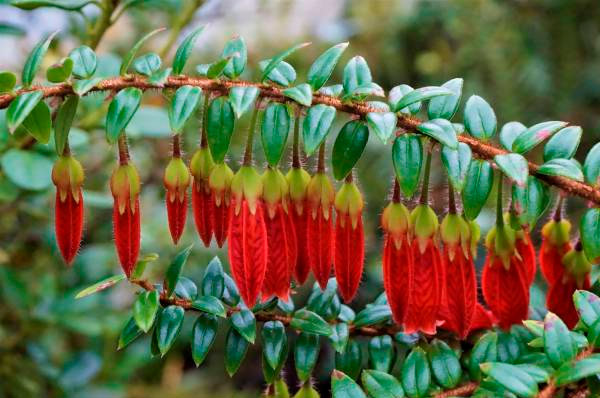
Chemical Composition
Specific studies on the chemical composition of Agapetes have been limited, but it is known that the plant contains various flavonoids and phenolic compounds that give the flowers and leaves their characteristic color. Organic acids and tannins, common in many heaths, are also present in small amounts.
No significant toxic or potent alkaloids have been recorded in Agapetes, making it relatively safe for cultivation indoors. However, consuming parts of the plant may cause individual reactions, as systematic research in this area is limited.
Origin
The natural range of Agapetes covers the mountainous forests of South and Southeast Asia, including countries such as China, Nepal, Bhutan, and northern India. The plants are often found in cool, humid locations, growing on trees as epiphytes or on rocky slopes enriched with forest litter.
In such conditions, Agapetes must adapt to high humidity, moderate temperatures, and slightly acidic soils, which has influenced its cultural requirements. It prefers a stable microclimate without sharp temperature fluctuations and an abundance of direct sunlight.
Ease of growing
Although Agapetes is not the most common indoor plant, it can be successfully grown indoors with some experience. Its main requirements include acidic, loose soil similar to that of rhododendrons and adequate humidity.
The main difficulties may arise in maintaining stable temperature and light conditions. Sharp changes in environmental parameters cause stress in Agapetes, leading to leaf drop and cessation of flowering. With the presence of a greenhouse or conservatory, the plant grows more comfortably.
Species and varieties
The genus Agapetes includes several dozen species, some of which are still insufficiently studied. The most well-known species include Agapetes serpens, Agapetes smithiana, and Agapetes rubra, which differ in the color and shape of their flowers. Cultivated hybrids with larger flowers or enhanced tolerance to temperature fluctuations are also available.
Commercial varieties have not gained wide popularity, making Agapetes a rare sight in garden centers. The plant is mainly distributed through specialized nurseries or through exchanges between collectors.
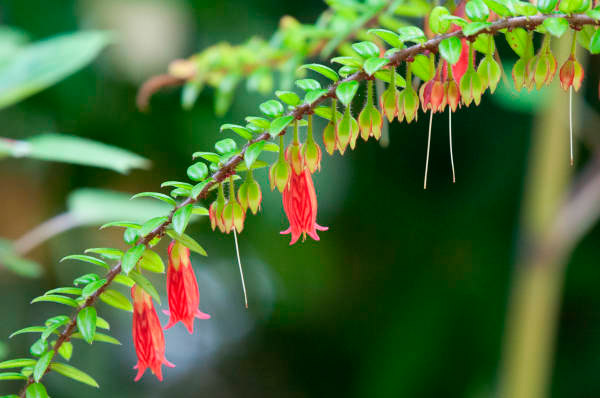
Agapetes serpens
Size
In its natural habitat, Agapetes can reach a height of 1–2 meters, forming spreading branches with drooping shoots. In indoor cultivation, its size is more modest, usually not exceeding 60–80 cm in height.
The crown diameter can reach 40–50 cm with sufficient soil volume and regular pruning. Compact forms allow Agapetes to be successfully grown on windowsills, in shelving systems, or in small greenhouses.
Growth rate
Agapetes grows moderately, especially when provided with suitable conditions. During the growing season (spring–summer), the shoots can elongate by 5–10 cm per year, while in winter, growth nearly stops, and the plant enters a state of relative dormancy.
Under favorable conditions, similar to those of tropical environments, the growth rate is higher. However, excessively high temperatures or water stagnation can suppress the root system, affecting development rates.
Lifespan
Like most evergreen shrubs, Agapetes is a perennial capable of retaining its ornamental appeal and producing new shoots for many years. When grown indoors, the plant can thrive and bloom for 5–7 years or more, provided that regular substrate renewal and proper care routines are followed.
Over time, the lower shoots may partially lignify and lose leaves, which is natural for aging shrubs. To maintain its decorative appearance, rejuvenating pruning or cuttings are recommended.
Temperature
The optimal temperature range for Agapetes is 15–22 °C. During the summer, the plant can tolerate slight temperature increases up to 25–27 °C, but only if the humidity is high and the room is regularly ventilated.
In winter, it is preferable to maintain cooler conditions (12–15 °C), which helps the plant "rest" and develop new buds for the coming season. Temperatures below 10 °C or above 30 °C for extended periods can be stressful and may slow down growth or cause death.
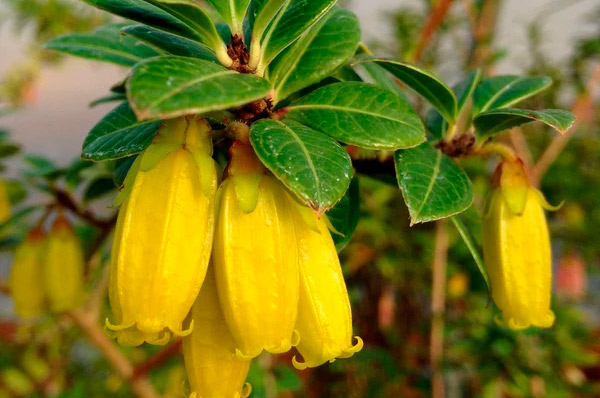
Agapetes smithiana
Humidity
Agapetes prefers high air humidity (60–80%) due to its mountainous forest origin. Dry air in winter, typical of heated indoor spaces, negatively affects the leaves and root system. Regular leaf spraying, the use of humidifiers, or placing water containers near the plant is recommended.
However, excessive moisture with insufficient ventilation can lead to fungal diseases. A balance must be maintained by ensuring fresh air and preventing water from stagnating.
Lighting and room placement
Agapetes needs diffused but relatively bright light. Direct midday rays can burn its delicate leaves, so it is optimal to place the plant near east or west-facing windows. Morning and evening sunlight will not harm it.
In conditions of insufficient natural light (e.g., northern rooms), additional grow lights may be used. Care should be taken to ensure the light falls evenly; otherwise, the shoots may start to bend toward the light source.
Soil and substrate
Like many members of the heath family, Agapetes requires acidic and loose soil. A recommended mixture consists of 40% heath soil or a prepared substrate for azaleas, 30% peat, 20% coarse sand or perlite, and 10% leaf mold. This structure ensures good drainage and air exchange for the roots.
The optimal pH of the soil is 5.5–6.5. A drainage layer made of expanded clay or small gravel at the bottom of the pot is essential to prevent water stagnation and root rot.
Watering (summer and winter)
In summer, Agapetes should be watered regularly, but without allowing water to stagnate in the saucer. The top layer of the substrate should dry slightly between waterings, but the soil should not dry out completely. Hot days require additional watering or spraying.
In winter, watering is reduced, especially if the plant is kept in a cool room. It is sufficient to moisten the soil once every 7–10 days, depending on the condition of the substrate and air humidity. Overwatering during the cold season leads to root rot.
Fertilizing and feeding
Agapetes responds well to fertilizers for acid-loving plants (e.g., for azaleas or rhododendrons). During the active growing season (spring–summer), fertilizers should be applied every 2–3 weeks, using half the recommended dose.
It is convenient to alternate organic and mineral fertilizers, balancing macro- and microelements. In autumn and winter, fertilization is minimized or completely stopped, allowing the plant to enter dormancy.
Flowering
Agapetes flowers are bell-shaped, usually bright red or pink, and can appear singly or in small clusters in the leaf axils. Flowering in different species lasts from a few weeks to a month, giving the plant an exotic appearance.
To stimulate bud formation, it is important to provide the plant with a period of relative dormancy and adequate humidity. Sufficient but diffused lighting is also a key factor.
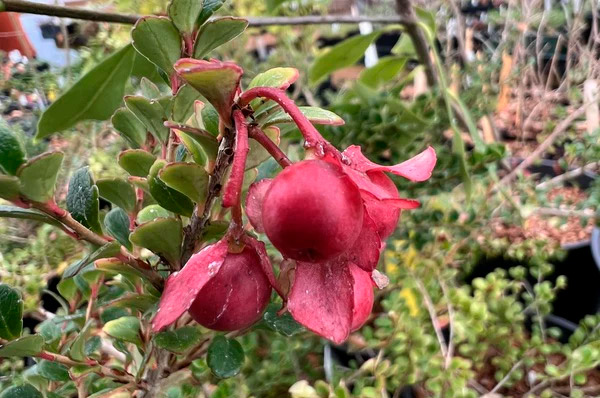
Agapetes rubrobracteata
Propagation
Agapetes is mainly propagated by cuttings of semi-woody shoots 8–10 cm long. The cuttings are rooted in a moist substrate with added peat and perlite at a temperature of about 20–22 °C. Roots form within 3–4 weeks.
Growing from seeds is less common due to the low availability of seed material. If seeds are obtained, they should be sown in acidic soil, maintaining high humidity and temperature, but germination may be uneven and show signs of the wild form.
Seasonal features
In spring, Agapetes enters an active growth phase, with new leaves emerging and buds forming. During summer, with sufficiently high humidity and temperature, the plant rapidly increases in size and may flower. During this period, it is essential to monitor watering and provide regular feeding.
In autumn and winter, when the daylight hours shorten, it is better to keep Agapetes in cooler conditions (12–15 °C) with moderate watering. This "rest" period promotes abundant flowering in the next season and prevents plant weakening.
Care features
When caring for Agapetes, stability in the microclimate without sharp fluctuations in humidity and temperature is key. Regular spraying of leaves, especially during dry periods, and monitoring the general state of the substrate are crucial.
On hot days, additional shading may be required to prevent the leaves from overheating. Regular inspection for pests and diseases allows early detection of issues and the implementation of corrective measures.
Home care
The first aspect to consider is the correct placement of the plant. Agapetes needs relatively bright but diffused light, so east or west-facing windows are preferable. If the sunlight is too intense, light curtains or blinds should be used.
The second important point is maintaining high humidity. Regular spraying, placing the pot on a tray with moist expanded clay, or using air humidifiers all make the microclimate more comfortable for Agapetes.
The third aspect is systematic watering. During summer, the substrate should remain slightly moist but not waterlogged. In winter, watering is reduced, avoiding overwatering at lower temperatures.
Finally, fertilization. Use weakly acidic fertilizers for heaths, applying them at half-strength every 2–3 weeks. In the cold season, one feeding per month or none at all, if the plant is clearly "resting," is sufficient.
Repotting
The choice of pot depends on the size of the roots: if the root system has filled the previous volume, the plant should be repotted into a new pot that is 2–3 cm larger in diameter. An excessively large pot can lead to soil acidification and slower growth.
The best time to repot is early spring, before the plant enters its active growth phase. After repotting, keep the plant in partial shade for a few days, allowing the roots to adjust to the new substrate.
Pruning and crown shaping
Shaping pruning is not necessary, as Agapetes naturally maintains a neat form. Only dry or damaged shoots are removed, and excessively long branches can be slightly shortened to encourage side branching.
Pruning is best done at the end of winter or in spring when new shoots are growing. Use sharp, sterile tools to minimize the risk of infection.
Possible problems and solutions
The main diseases are associated with overwatering and insufficient soil aeration (root rot, fungal infections). The solution is to reduce watering frequency, ensure drainage, and treat the plant with fungicide if necessary.
Nutrient deficiencies manifest as leaf chlorosis (yellowing with green veins). This can be addressed by feeding with acid-loving fertilizers and adjusting the soil pH. Care mistakes (overcooling, sudden decreases in humidity) lead to partial leaf drop.
Pests
The main pests attacking Agapetes are spider mites, aphids, and thrips. They prefer dry, warm air, so regular spraying and good ventilation reduce the risk of infestation.
In case of pests, use insecticides according to the instructions, as well as biopreparations (infusions of wormwood, onion, or soap). Prevention and regular leaf inspections are essential for successful cultivation.
Air purification
Agapetes, like many evergreen plants, helps enrich the air with oxygen and partially binds volatile organic compounds. Its broad leaves capture dust, reducing its concentration in the room.
Although its "filtering" capabilities are not as significant as larger plants, Agapetes contributes to creating a healthy atmosphere in the room. Regularly wiping the leaves enhances their ability to photosynthesize and improves air purification efficiency.
Safety
There is no information indicating significant toxicity of Agapetes to humans or pets. However, consuming parts of the plant may cause individual allergic or digestive reactions, as the heath family includes species with various chemical compounds.
When pruning or repotting, it is better to wear gloves, as the sap may cause mild irritation to the skin in sensitive individuals. If redness develops, wash the affected area with water and consult a doctor if necessary.
Wintering
In winter, Agapetes prefers cool conditions (12–15 °C) and reduced watering. This "cold" wintering allows the plant to redistribute resources and accumulate energy for upcoming flowering. If humidity is increased, the leaves will retain their rich color and not fall off in large numbers.
At the start of spring, when the daylight hours increase, Agapetes is returned to warmer conditions, gradually increasing watering frequency and providing additional feeding. This activates the growth of new shoots and promotes flowering.
Beneficial properties
Agapetes, with its distinct ornamental value, decorates interiors and creates an atmosphere in the room similar to tropical forests. Observing the plant's growth, flowering, and development has a positive effect on emotional well-being, reducing stress levels.
Some researchers suggest that the chemical compounds in the leaves and flowers may have mild antimicrobial effects, as seen in many heaths. However, there is no confirmed scientific evidence of practical significance for medicine.
Use in traditional medicine or folk remedies
In the regions where Agapetes is native, there is limited use of infusions or decoctions made from its leaves, which are used as an anti-inflammatory agent. However, these methods remain part of local folklore and are not supported by large-scale scientific studies.
Attempts to use Agapetes for medicinal purposes outside its native range are rare. Before using the plant for self-treatment, it is advisable to consult a phytotherapist and be aware of potential allergic reactions.
Use in landscape design
In warm climates, Agapetes is grown outdoors in the partial shade of large trees, where it can act as an epiphyte or grow as underbrush. Its bright bell-shaped flowers provide a beautiful decorative accent, especially in group plantings.
Vertical gardens and hanging compositions with Agapetes are used less frequently, but with proper watering and humidity maintenance, the plant can decorate green walls or hanging baskets. It is important to remember its demands for substrate quality and acidity.
Compatibility with other plants
Agapetes pairs well with other members of the heath family (rhododendrons, azaleas) and ferns, as they share similar soil acidity and moisture requirements. Such companionship helps maintain an overall microclimate that is favorable for all plants in the composition.
Combining with succulents or plants that prefer alkaline soils is usually unsuccessful, as their requirements for substrate and watering differ greatly. When creating mixed plantings, it is advisable to focus on plants with similar ecological niches.
Conclusion
Agapetes is a rare and exquisite plant from the heath family, attracting attention with its bell-shaped flowers and evergreen foliage. Its cultivation requires some effort in maintaining an acidic, humid, and sufficiently illuminated environment, but under these conditions, Agapetes can delight gardeners with long-lasting flowering and unparalleled aesthetics.
Understanding the species' characteristics, including its mountainous origin, need for increased humidity, and tendency for relatively cool wintering, helps successfully cultivate Agapetes indoors or in a greenhouse. Thanks to its ornamental value, the plant can become a valuable addition to an exotic plant collection and create an impressive composition when combined with other members of the heath family.
